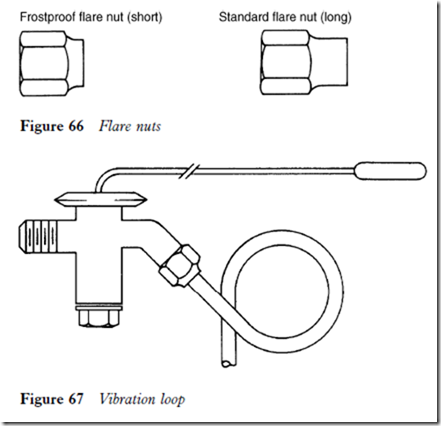Pipework fittings
Although it is general practice to install pipework where possible with brazed joints, flare fittings are still used. These should be kept to a minimum because too many in a circuit will create a pressure drop.
Flare unions and service and shut-off valve connections do not determine the diameter of the system pipework. It may be necessary to change a flare union to eliminate a pressure drop across a component.
A common cause of failure is the partial or complete loss of the refrigerant charge resulting from the use of an incorrect flare nut. A frostproof flare nut, for example, should be used on suction lines where extreme temperature changes can take place, i.e. frost on the suction line melting during an off cycle and freezing when the unit restarts. It is possible for ice to form between the long shoulder of a standard flare nut and the tubing; expansion of the ice and contraction of the tubing eventually fractures the flare (see Figure 66).
When a frostproof type is used on the high side of the system, vibration from gas pulsations at the compressor discharge or from an evaporator fan, plus the weight of the expansion valve, can cause the flare to rupture. The long shoulder
of the standard flare nut can prevent this by virtue of the reinforcement it provides, restricting lateral movement of the tubing and flare.
A vibration loop formed in a liquid line or in the small diameter tubing of a control line can have a twofold advantage. It will protect the flare against vibration, and may allow easy reforming of the tubing when a valve or control has to be changed (see Figure 67).
The leak potential is also increased when a flare union is used instead of a half union for connecting control lines to compressors or components. A half union does not have the seat facility of a flare union, although in some instances the threads may be the same. The difference is depicted in Figure 68.
